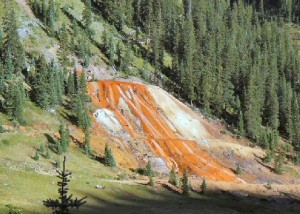Welcome Students!
Mining has been an important economic activity in the United States for hundreds of years. Historic mining created towns, provided people with jobs, and produced minerals to sustain industry throughout the world. Despite these notable activities, as historic mining moved to new areas it left communities impoverished and environmentally degraded. This module will focus on one major aspect of environmental degradation, acid mine drainage.
Acid mine drainage (AMD) is a water pollution source in states where historic mining took place. When it drains into streams, the low pH and high metals content can leave the streams uninhabitable by plant and animal life and potentially harmful to humans.
This module will teach you about pH and other parameters relevant to mining related water quality issues, the chemistry behind the formation of AMD, and the reclamation techniques used to minimize the damage caused by AMD.
The Upper South Platte watershed is one of the many watersheds in Colorado where historic mining has left its mark. Addressing pollution from mining falls into CUSP’s mission to protect the water quality and environmental health of the watershed. Students who complete this module will have the opportunity to visit an abandoned mine site with CUSP staff to collect data for water quality monitoring.
Sincerely,
Sarah Lykens
Outreach Assistant
Coalition for the Upper South Platte
http://cusp.ws
Student Information
The online pre-assessment can be accessed here. Your teacher will give you the access code and your log in name. Use the same log in name and get the access code from your teacher for the post-assessment at the end of the module found here.
Objectives
Students will: (1) understand the origin of acid mine drainage and the chemistry of its formation; (2) understand the physical and chemical processes behind acid mine drainage environmental impacts and remediation techniques; (3) Research acid mine drainage remediation techniques and be able to select appropriate techniques for an acid mine drainage scenario; (4) Participate in fieldwork to observe and monitor the effects of acid mine drainage.
Objectives and Education Standards
ACTIVITIES
Student pH, Alkalinity, Acidity, Oh My! Instructions
Student Sedimentation Instructions
DOCUMENTS and MATERIALS
Vocabulary
Student pH Information
Student pH Worksheets
Remediation Wetlands Handout
AMD and Treatment Handout
Remediation Scenario Handout
Iron Mountain Mine Case Study
LINKS
“Acid Mine Drainage.” WVU Extension Service. West Virginia University. http://anr.ext.wvu.edu/land_reclamation/acid-mine-drainage.
AMRClearinghouse.org. Abandoned Mine Reclamation Clearinghouse. http://www.amrclearinghouse.org/.
Fripp, Jon, Paul F. Ziemkiewicz, and Hari Charkavorki. “Acid Mine Drainage Treatment.” US AEC, May 2000. http://el.erdc.usace.army.mil/elpubs/pdf/sr14.pdf.
Ford, K.L. 2003. Passive treatment systems for acid mine drainage. Technical Note 409. BLM/ST/ST-02/001+3596. Bureau of Land Management Web-based report available online at http://www.blm.gov/nstc/library/techno2.htm.
Golden, Bruce. “Exploring the Process of Sedimentation.” Western Pennsylvania Coalition for Abandoned Mine Reclamation. Abandoned Mine Reclamation Clearinghouse. http://www.amrclearinghouse.org/Sub/education/lessonplans/Sedimentation.pdf.
“Iron Mountain Mine.” Abandoned Mine Lands Case Study. United States Environmental Protection Agency. http://www.epa.gov/aml/tech/imm.pdf.
“Iron Mountain Mine.” Pacific Southwest, Region 9: Superfund. United States Environmental Protection Agency. http://yosemite.epa.gov/r9/sfund/r9sfdocw.nsf/vwsoalphabetic/Iron+Mountain+Mine?OpenDocument.
“pH, Alkalinity, Acidity, Oh My!” Saint Vincent College Environmental Education Center. http://facweb.stvincent.edu/eec/PDF/Modules/phalkalinityacidityohmy.pdf.
“Record of Decision. Old/No. 8 Seep. Iron Mountain Mine. Shasta County, California.” United States Environmental Protection Agency. 24 September 1993. http://yosemite.epa.gov/r9/sfund/r9sfdocw.nsf/3dc283e6c5d6056f88257426007417a2/259072c75b6d3ac3882577490082996c/$FILE/IMM%20-%20ROD%209-24-93.pdf.
Sobolewski, A. 1996. Wetlands for Treatment of Mine Drainage. WWW document located at URL http://technology.infomine.com/enviromine/wetlands/Welcome.htm.
Zipper, C., J. Skousen, and C. Jage. “Passive Treatment of Acid-Mine Drainage.” Virginia Cooperative Extension. 2011. http://pubs.ext.vt.edu/460/460-133/460-133_pdf.pdf.
REFERENCES
“Acid Mine Drainage Remediation.” Colorado State University. http://www.engr.colostate.edu/~apruden/Research%20Group/Projects/Acid%20Mine%20Drainage.htm.
“Basic Information.” Engineering Technical Support Center. EPA. http://www.epa.gov/ordntrnt/ORD/NRMRL/lrpcd/etsc/basic.html.
Ford, K.L. 2003. Passive treatment systems for acid mine drainage. Technical Note 409. BLM/ST/ST-02/001+3596. Bureau of Land Management Web based report available online at http://www.blm.gov/nstc/library/techno2.htm.
Fripp, Jon, Paul F. Ziemkiewicz, and Hari Charkavorki. “Acid Mine Drainage Treatment.” US AEC, May 2000. http://el.erdc.usace.army.mil/elpubs/pdf/sr14.pdf.
“Geology and Earth Science Terms and Definitions.” Geology Definitions. Geology.com. http://geology.com/geology-dictionary.shtml.
Golden, Bruce. “Ask Me About Pyrite.” Western Pennsylvania Coalition for Abandoned Mine Reclamation. Presentation.
“Reverse Osmosis.” http://science.howstuffworks.com/reverse-osmosis2.htm.
SAPS & Vertical Flow Reactors. AMRClearinghouse.org. http://www.amrclearinghouse.org/Sub/AMDtreatment/SAPS-VFP’S.htm.
Sares, Matthew A. “Geology, Mining, and Water Quality.” Colorado Geological Survey. Presentation.
Trout Unlimited Assault on San Juan County Colorado. July 2010. http://www.savethesanjuans.com/Save%20the%20San%20Juans%20011611.htm.
“Word Lists.” High School Science Vocabulary. VocabularySpellingCity.com. http://www.spellingcity.com/high-school-science-vocabulary.html.
ADDITIONAL RESOURCES
“Acid Mine Drainage.” Exploring the Environment – Water Quality. http://www.cotf.edu/ete/modules/waterq/wqacidmine.html.
*Information on AMD water chemistry parameters.
“Acid Mine Drainage.” Water: Polluted Runoff. U.S. Environmental Protection Agency. http://water.epa.gov/polwaste/nps/acid_mne.cfm.
*General AMD information with links to other resources.
“Acid Mine Drainage Formation.” Ecosystem Restoration. Montana State University Bozeman. http://ecorestoration.montana.edu/mineland/guide/problem/impacts/amd_formation.htm. *Environmental Impacts of AMD and links.
Comp, T. Allan. “Welcome to the AMD&ART Project in Vintondale, Pennsylvania.”AMD&ART Project in Vintondale, Pennsylvania. AMD&ART. http://www.amdandart.org/projectindex.html.
*Incorporating art into AMD remediation techniques.
Bonnett, Bob. “A Natural Wetland Used to Treat Acid Mine Drainage Entering Manila Creek Amherst-Plymouth Wildlife Management Area Putnam County, West Virginia.” Heizer-Manila Watershed Organization. http://manila_wetland.tripod.com/manila_amd_wetland.htm.
*Example of wetlands to treat AMD.
Sobolewski, A. “Coal-generated AMD.” Constructed Wetlands for Treatment of Mine Drainage. 1996. http://technology.infomine.com/enviromine/wetlands/coal.htm.
*Specifics for coal-generated AMD.
Sobolewski, A. “Precious and Base-metal Mines.” Constructed Wetlands for Treatment of Mine Drainage. 1996. http://technology.infomine.com/enviromine/wetlands/metal.htm. *Specifics for metal-generated AMD.
“Tools to Define Pre-Mining Water-Quality Restoration Targets.” USGS Toxic Substances Hydrology Program. U.S. Geological Survey. http://toxics.usgs.gov/highlights/premining_wq.html.
*Examining pre-mining water quality parameters.
